Regent of Thailand

In Thailand, the regent (Thai: ผู้สำเร็จราชการแทนพระองค์) is a person who exercises the official functions of a monarch of Thailand when the monarch is incapable of functioning or during a period of interregnum.
Appointment[edit]
By Old Royal Customs[edit]
Ancient custom dictates that the heir to the last king rule only as a regent and not as a king until he is officially consecrated. An unconsecrated king is not considered qualified to carry out the divine and priestly function of a Devarāja (or God-king). Until the coronation rites are completed the new king must exclude the prefix Phrabat (พระบาท) from his royal title, he cannot enact a royal command, nor sit under the nine-tiered umbrella (he must make do with only seven tiers). As a result, it was customary for a king to go through the coronation ceremonies as soon as he had succeeded to the throne.[1][2][3][4]
In Modern Era[edit]
According to the constitution of Thailand 2017, there might be a regent when the monarch is unable to function and there will be a regent when the throne is vacant.
Incapacity of monarch[edit]

In accordance with the 2017 constitution, if the monarch is to leave the country or is unable to perform his duties for whatever reason, he may appoint any regent or council of regency. If he does make an appointment, the president of the National Assembly of Thailand will countersign the appointment.[5]
If the monarch does not or cannot appoint any regent due to his minority or for any other reason and the Privy Council of Thailand finds the regency is necessary, the Privy Council will nominate a regent or council of regency to the president of the National Assembly for further appointment in the name of the monarch. The nominees are required to be those having been picked beforehand by the monarch and they must be nominated in accordance with the order of precedence designated beforehand by the monarch also.[6]
Until a regent or council of regency is appointed, the president of the Privy Council will serve as the regent ad interim.[7]
The constitution also requires an appointed regent to take the following oath of office amongst the National Assembly before assuming office:[8]
I, (name of the regent), do hereby declare that I will be loyal to His Majesty King (the king's name), and will faithfully carry out my duties in the interest of the nation and her people, and will also uphold and observe the Constitution of the Kingdom of Thailand in all sincerity.
Formerly, the law required regency during the incapacity of the monarch. In January 2017, King Rama X made an unprecedented move to change a draft constitution (later promulgated as the 2017 constitution) by removing the need for the monarch to appoint any regent in such an event, despite the draft having already been approved in a referendum.[9][10]
Interregnum[edit]
In accordance with the 2017 constitution, when the throne becomes vacant, the president of the Privy Council of Thailand will act as the regent ad interim until a monarch is installed.[11]
But if the vacancy takes place when there already is a regent, appointed by the previous monarch or by the president of the National Assembly due to the monarch's incapacity, that regent will continue to function until a monarch is enthroned.[11] If the appointed regent is unable to function, the president of the Privy Council will also serve as the regent ad interim.[12]
Flag[edit]
The regent is given an official flag by the Flag Act 1979. It is a white square flag with a shield of the national flag at the centre, topped by the mythological bird garuda, which is the national emblem of Thailand.[13]
List of regents[edit]
Fourth Reign[edit]
| Portrait | Name | Date of Appointment | Ceased to be Regent | Note |
|---|---|---|---|---|
| King Mongkut (Rama IV) | ||||
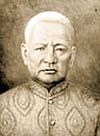
|
Somdet Chao Phraya Borom Maha Prayurawongse (Tish Bunnag) |
1851 | 1855 | The post established for the first time in Rattanakosin era. Appointed as a sinecure, functionally as prime minister. |
Fifth Reign[edit]
| Portrait | Name | Date of Appointment | Ceased to be Regent | Note |
|---|---|---|---|---|
| King Chulalongkorn (Rama V) | ||||

|
Somdet Chao Phraya Borom Maha Sri Suriwongse (Chuang Bunnag) |
1 October 1868 | 16 November 1873 | Appointed regent by the Council of Ministers, until the king reached his majority at the age of 20. |
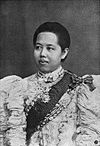
|
Queen Saovabha Phongsri | 7 April 1897[14] | 16 December 1897 | Appointed regent for the duration of the king's first visit to Europe. After the king's return title was elevated to Queen Regent. |

|
Crown Prince Maha Vajiravudh |
27 March 1907 | 17 November 1907 | Appointed regent for the duration of the king's second visit to Europe. |
Sixth Reign[edit]
| Portrait | Name | Date of Appointment | Ceased to be Regent | Note |
|---|---|---|---|---|
| King Vajiravudh (Rama VI) | ||||
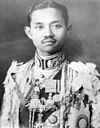
|
Prince Prajadhipok Sakdidej, the Prince of Sukhothai |
1925 | 25 November 1925 | Appointed regent during the illness of the king, after the king's death on 25 November 1925, himself succeeded to the throne as King Rama VII. |
Seventh Reign[edit]
| Portrait | Name | Date of Appointment | Ceased to be Regent | Note |
|---|---|---|---|---|
| King Prajadhipok (Rama VII) | ||||

|
Prince Paribatra Sukhumbandhu, the Prince of Nakhon Sawan |
9 April 1932 | 8 May 1932 | Appointed regent for the duration of the king's summer holiday in Hua Hin, Prachuap Khiri Khan Province. |

|
Prince Chitcharoen, the Prince Narisara Nuwattiwong |
12 January 1934[15] | 2 March 1935 | Appointed regent while the king visited Europe for medical treatment, regency ended with the king's abdication of the throne. |
Eighth Reign[edit]
| Portrait | Name | Date of Appointment | Ceased to be Regent | Note |
|---|---|---|---|---|
| King Ananda Mahidol (Rama VIII) | ||||
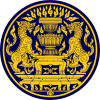
|
Cabinet of Siam act as a regency council pro tempore | 2 March 1935 | 7 March 1935 | The Cabinet of Siam filled-in as a regency council pro tempore during a brief interregnum in according to Constitution of Siam 1935 [16] |

|
Prince Oscar Anuvatana | 7 March 1935[17] | 12 August 1935 | Appointed president of the three members regency council, during the king's minority (10 years of age at the time) and absence, as he was living in Switzerland. Died in office (committed suicide). |

|
Prince Aditya Dibabha | 31 July 1944 | Succeeded Prince Oscar as president. Later resigned from office and ceased to be regent, died in 1945.[18] | |

|
Chao Phraya Yomarath (Pan Sukhum) |
30 December 1938 | Died in office | |
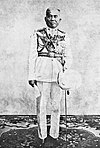
|
Chao Phraya Bijayendra Yodhin (General Um Indrayodhin) |
21 August 1935[19] | 21 July 1942 | Appointed regent to replace Prince Oscar. Died in office. |

|
Luang Praditmanutham (Pridi Banomyong) |
16 December 1941[20] | 20 September 1945 | Appointed regent to replace Chao Phraya Yomarath, previously held office as Minister of Finance. After the resignation of Prince Aditya Dibabha became the sole regent, until the return of the king in 1946.[18] Later became the 7th prime minister of Thailand in 1946. |
Ninth Reign[edit]
| Portrait | Name | Date of Appointment | Ceased to be Regent | Note |
|---|---|---|---|---|
| King Bhumibol Adulyadej (Rama IX) | ||||

|
Regency pro tempore under the Senate | 9 June 1946 | 16 June 1946 | After the death of Ananda Mahidol, 3 most senior senators were given the power of regency pro tempore under the Constitution of 1946 until the appointment of permanent regency council The regency council was composed of: 1. Phra Suthammavinijchai 2. Praya Nonrajasuvaj 3. Sanguan Juthathemi [21] |
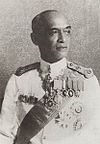
|
Prince Rangsit Prayurasakdi, the Prince of Chainat |
16 June 1946[22] | 7 November 1947 | Appointed two person regency council, when the king decided to return to his studies at the University of Lausanne in Switzerland. |

|
Phraya Manavaratsevi (Plod Vichear na Songkhla) | |||

|
Regency under the Privy Council | 9 November 1947[23] | 23 January 1949 | After the Siamese coup d'état of 1947 a new Privy Council was created and was given the power of regency under the Temporary Constitution of 1947. The council was composed of: 1. Prince Rangsit Prayurasakdi, the Prince of Chainat 2. Prince Dhani Nivat, the Prince Bidyalabh Bridhyakon 3. Prince Alongkot, the Prince Adireksorn Udomsakdi 4. Phraya Manavaratsevi (Plod Vichear na Songkhla) 5. General Adun Adundetcharat (Bat Phuengphrakhun) The council was relieved of the regency with the promulgation of the 1949 Constitution. |

|
Prince Rangsit Prayurasakdi, the Prince of Chainat |
23 June 1949[24] | Late 1949 | Appointed sole regent by recommendation of the National Assembly. Regency ended when the king returned to Thailand for his coronation ceremony on 5 May 1950. |
| 5 June 1950[25] | 7 March 1951 | Appointed regent during the king's travel and stay in Switzerland. Died in Office. | ||

|
Prince Dhani Nivat, the Prince Bidyalabh Bridhiyakon |
12 March 1951[26] | 29 November 1952 | Replace Prince Rangsit as regent. Regency ends after the abolition of constitution of Thailand 1949 [27] |

|
Coup Group in charge as the Cabinet of Thailand act as a regency council pro tempore | 29 November 1952 | 3 December 1952 | Coup Group acted as the Cabinet of Thailand filled-in a regency council duty in according to Constitution of Siam 1935 [16] Regency ends after the King returns to Thailand.[28] |

|
Queen Sirikit of Thailand | 22 October 1956[29] | 5 November 1956 | Appointed regent during the king's absence as a Bhikkhu monk in the Buddhist Sangha (at Wat Bowonniwet Vihara). Afterwards title elevated to Queen Regent. |

|
Princess Srinagarindra, the Princess Mother of Thailand | 18 December 1959[30] | 21 December 1959 | State visit to the Republic of Vietnam by the king and queen. |
| 9 February 1960[31] | 16 February 1960 | State visit to the Republic of Indonesia by the king and queen. | ||
| 2 March 1960[32] | 5 March 1960 | State visit to the Union of Burma by the king and queen. | ||
| 14 June 1960[33] | 1960 | State visit to the United States of America and European countries by the king and queen. | ||
| 11 March 1962[34] | 22 March 1962 | State visit to the Islamic Republic of Pakistan by the king and queen. | ||
| 20 June 1962[35] | 27 June 1962 | State visit to the Federation of Malaya by the king and queen. | ||
| 17 August 1962[36] | 13 September 1962 | State visit to New Zealand and Australia by the king and queen. | ||

|
Prince Dhani Nivat, the Prince Bidyalabh Bridhiyakon (President of the Privy Council) |
27 May 1963[37] | 6 June 1963 | State visit to Japan and Republic of China by the king and queen. |
| 9 July 1963[38] | 14 July 1963 | State visit to the Philippines by the king and queen. | ||

|
Princess Srinagarindra, the Princess Mother of Thailand | 12 September 1964[39] | 6 October 1964 | Visit to the Kingdom of Greece on the occasion of the marriage of King Constantine II and Anne-Marie of Denmark and the state visit to the Republic of Austria by the king and queen. |
| 15 July 1966[40] | 1966 | State visit to the United Kingdom by the king and queen. | ||
| 23 April 1967[41] | 30 April 1967 | State visit to the Imperial State of Iran by the king and queen. | ||
| 6 June 1967[42] | 1967 | State visit to the United States of America and Canada by the king and queen. | ||
Tenth Reign[edit]
| Portrait | Name | Date of commencement | Ceased to be Regent | Note |
|---|---|---|---|---|
| King Vajiralongkorn (Rama X) | ||||

|
General Prem Tinsulanonda | 13 October 2016 | 1 December 2016 | As the President of the Privy Council he became regent pro tempore upon the death of King Bhumibol Adulyadej under Constitution of the Kingdom of Thailand (Interim) 2014 This period was technically considered as an interregnum as Vajiralongkorn did not proclaim until 1 December and functioned as the crown prince in all royal ceremonies. Legally served during the first seven weeks of King Vajiralongkorn's reign.[43] |
See also[edit]
- Monarchy of Thailand
- List of Thai Monarchs
- List of Thai royal consorts
- Crown Prince of Thailand
- Regent
- List of regents
- Constitution of Thailand
References[edit]
- ^ Dhani Nivat 1949, p. 2
- ^ Quaritch Wales 1931, p. 70
- ^ Poopongpan 2007, p. 147
- ^ "General Prem leads chiefs of the executive, legislative and judicial branches to have an audience with HRH Crown Prince". Thai Public Broadcasting Service. 1 December 2016. Archived from the original on 6 September 2017. Retrieved 2017-09-06.
- ^ Council of State of Thailand (2017-04-11). "Ratthathammanūn hæng rātcha'ānāčhak thai phutthasakkarāt sǭng phan hā rǭi hoksip" รัฐธรรมนูญแห่งราชอาณาจักรไทย พุทธศักราช ๒๕๖๐ [Constitution of the Kingdom of Thailand, 2560 Buddhist Era]. Council of State of Thailand Law Library (in Thai). Bangkok: Council of State of Thailand. Retrieved 2017-04-18.
มาตรา ๑๖ ในเมื่อพระมหากษัตริย์จะไม่ประทับอยู่ในราชอาณาจักร หรือจะทรงบริหารพระราชภาระไม่ได้ด้วยเหตุใดก็ตาม จะทรงแต่งตั้งบุคคลคนหนึ่งหรือหลายคนเป็นคณะขึ้นให้เป็นผู้สำเร็จราชการแทนพระองค์หรือไม่ก็ได้ และในกรณีที่ทรงแต่งตั้งผู้สำเร็จราชการแทนพระองค์ ให้ประธานรัฐสภาเป็นผู้ลงนามรับสนองพระบรมราชโองการ
- ^ Council of State of Thailand (2017-04-11). "Ratthathammanūn hæng rātcha'ānāčhak thai phutthasakkarāt sǭng phan hā rǭi hoksip" รัฐธรรมนูญแห่งราชอาณาจักรไทย พุทธศักราช ๒๕๖๐ [Constitution of the Kingdom of Thailand, 2560 Buddhist Era]. Council of State of Thailand Law Library (in Thai). Bangkok: Council of State of Thailand. Retrieved 2017-04-18.
มาตรา ๑๗ ในกรณีที่พระมหากษัตริย์มิได้ทรงแต่งตั้งผู้สำเร็จราชการแทนพระองค์ตามมาตรา ๑๖ หรือในกรณีที่พระมหากษัตริย์ไม่สามารถทรงแต่งตั้งผู้สำเร็จราชการแทนพระองค์เพราะยังไม่ทรงบรรลุนิติภาวะหรือเพราะเหตุอื่น แต่ต่อมาคณะองคมนตรีพิจารณาเห็นว่า มีความจำเป็นสมควรแต่งตั้งผู้สำเร็จราชการแทนพระองค์และไม่อาจกราบบังคมทูลให้ทรงแต่งตั้งได้ทันการ ให้คณะองคมนตรีเสนอชื่อบุคคลคนหนึ่งหรือหลายคนเป็นคณะ ตามลำดับที่โปรดเกล้าโปรดกระหม่อมกำหนดไว้ก่อนแล้วให้เป็นผู้สำเร็จราชการแทนพระองค์ แล้วแจ้งประธานรัฐสภาเพื่อประกาศในพระปรมาภิไธยพระมหากษัตริย์แต่งตั้งผู้นั้นขึ้นเป็นผู้สำเร็จราชการแทนพระองค์
- ^ Council of State of Thailand (2017-04-11). "Ratthathammanūn hæng rātcha'ānāčhak thai phutthasakkarāt sǭng phan hā rǭi hoksip" รัฐธรรมนูญแห่งราชอาณาจักรไทย พุทธศักราช ๒๕๖๐ [Constitution of the Kingdom of Thailand, 2560 Buddhist Era]. Council of State of Thailand Law Library (in Thai). Bangkok: Council of State of Thailand. Retrieved 2017-04-18.
มาตรา ๑๘ ในระหว่างที่ไม่มีผู้สำเร็จราชการแทนพระองค์ตามมาตรา ๑๗ ให้ประธานองคมนตรีเป็นผู้สำเร็จราชการแทนพระองค์เป็นการชั่วคราวไปพลางก่อน...
- ^ Council of State of Thailand (2017-04-11). "Ratthathammanūn hæng rātcha'ānāčhak thai phutthasakkarāt sǭng phan hā rǭi hoksip" รัฐธรรมนูญแห่งราชอาณาจักรไทย พุทธศักราช ๒๕๖๐ [Constitution of the Kingdom of Thailand, 2560 Buddhist Era]. Council of State of Thailand Law Library (in Thai). Bangkok: Council of State of Thailand. Retrieved 2017-04-18.
มาตรา ๑๙ ก่อนเข้ารับหน้าที่ ผู้สำเร็จราชการแทนพระองค์ซึ่งได้รับการแต่งตั้งตามมาตรา ๑๖ หรือมาตรา ๑๗ ต้องปฏิญาณตนในที่ประชุมรัฐสภาด้วยถ้อยคำดังต่อไปนี้ 'ข้าพเจ้า (ชื่อผู้ปฏิญาณ) ขอปฏิญาณว่า ข้าพเจ้าจะจงรักภักดีต่อพระมหากษัตริย์ (พระปรมาภิไธย) และจะปฏิบัติหน้าที่ด้วยความซื่อสัตย์สุจริต เพื่อประโยชน์ของประเทศและประชาชน ทั้งจะรักษาไว้และปฏิบัติตามซึ่งรัฐธรรมนูญแห่งราชอาณาจักรไทยทุกประการ'...
- ^ Cochrane, Liam (2017-01-11). "New Thai King requests constitutional changes to 'ensure his royal powers': Prime Minister". ABC News. ABC. Retrieved 2017-04-20.
- ^ "Thai king's office seeks changes to draft constitution". Reuters. Reuters. 2017-01-10. Retrieved 2017-04-20.
- ^ a b Council of State of Thailand (2017-04-11). "Ratthathammanūn hæng rātcha'ānāčhak thai phutthasakkarāt sǭng phan hā rǭi hoksip" รัฐธรรมนูญแห่งราชอาณาจักรไทย พุทธศักราช ๒๕๖๐ [Constitution of the Kingdom of Thailand, 2560 Buddhist Era]. Council of State of Thailand Law Library (in Thai). Bangkok: Council of State of Thailand. Retrieved 2017-04-18.
มาตรา ๒๒ ในระหว่างที่ยังไม่มีประกาศอัญเชิญองค์พระรัชทายาทหรือองค์ผู้สืบราชสันตติวงศ์ขึ้นทรงราชย์เป็นพระมหากษัตริย์ตามมาตรา ๒๑ ให้ประธานองคมนตรีเป็นผู้สำเร็จราชการแทนพระองค์เป็นการชั่วคราวไปพลางก่อน แต่ในกรณีที่ราชบัลลังก์หากว่างลงในระหว่างที่ได้แต่งตั้งผู้สำเร็จราชการแทนพระองค์ไว้ตามมาตรา ๑๖ หรือมาตรา ๑๗ หรือระหว่างเวลาที่ประธานองคมนตรีเป็นผู้สำเร็จราชการแทนพระองค์ตามมาตรา ๑๘ วรรคหนึ่ง ให้ผู้สำเร็จราชการแทนพระองค์นั้น ๆ แล้วแต่กรณี เป็นผู้สำเร็จราชการแทนพระองค์ต่อไป ทั้งนี้ จนกว่าจะได้ประกาศอัญเชิญองค์พระรัชทายาทหรือองค์ผู้สืบราชสันตติวงศ์ขึ้นทรงราชย์เป็นพระมหากษัตริย์...
- ^ Council of State of Thailand (2017-04-11). "Ratthathammanūn hæng rātcha'ānāčhak thai phutthasakkarāt sǭng phan hā rǭi hoksip" รัฐธรรมนูญแห่งราชอาณาจักรไทย พุทธศักราช ๒๕๖๐ [Constitution of the Kingdom of Thailand, 2560 Buddhist Era]. Council of State of Thailand Law Library (in Thai). Bangkok: Council of State of Thailand. Retrieved 2017-04-18.
มาตรา ๒๒...ในกรณีที่ผู้สำเร็จราชการแทนพระองค์ซึ่งได้รับการแต่งตั้งไว้และเป็นผู้สำเร็จราชการแทนพระองค์ต่อไปตามวรรคหนึ่งไม่สามารถปฏิบัติหน้าที่ได้ ให้ประธานองคมนตรีทำหน้าที่ผู้สำเร็จราชการแทนพระองค์เป็นการชั่วคราวไปพลางก่อน
- ^ Office of the Council of State of Thailand (n.d.). "Unofficial translation: Flag Act, BE 2522 (1979)" (PDF). Bangkok: Office of the Council of State of Thailand. Retrieved 2016-10-12.
Section 43. Flags Showing Positions in General are: (1) Standard for the Regent of Thailand which is square shape with white field; in the middle of the flag, there is a yellow coat of arm with the width of 1 part out of 2 parts of the width of the flag; inside the yellow coat of arm, there is another coat of arm with the colours of the National Flag with the width of 3 parts out of 5 parts of the width of the yellow coat of arm; Above the coats of arm, there is a red garuda which is of the same size as the yellow coat of arm;...
- ^ Royal Gazette, Royal Order on the Regent, Volume 13, Chapter 51, Page 599, 21 March 115 Rattanakosin Era
- ^ Royal Gazette, Royal Command on the appointment of the Regent, Volume 50, Page 838, 11 January 2476 B.E.
- ^ a b Article 10,Constitution of Siam 1935
- ^ Royal Gazette, Announcement of the appointment of the Regency Council, Volume 41, Page 1332, 7 March 2477 B.E.
- ^ a b Royal Gazette, Appointment of Regent, Volume 61, Chapter 45, Page 730, 1 August 2487 B.E.
- ^ Royal Gazette, Naming of a replacement to the Regency Council and the appointment of a new President, Volume 52, Page 1260, 21 August 2478 B.E.
- ^ Royal Gazette, Naming of a replacement to the Regency Council, Volume 58, Page 1821, 16 December 2484 B.E.
- ^ Royal Gazette, Announcement on the appointment of the ministers, Volume 62, Chapter 42, Page 3, 13 June 2489 B.E.
- ^ Royal Gazette, Announcement of the appointment of the Regency Council, Volume 63, Chapter 48, Page 240, 25 June 2489 B.E.
- ^ Royal Gazette, Announcement on the appointment of the establishment of the Privy Council, Volume 64, Chapter 54, Page 688, 11 November 2490 B.E.
- ^ Royal Gazette, Announcement on the appointment of the Regent, Volume 66, Chapter 34, Page 491, 28 June 2492 B.E.
- ^ Royal Gazette, Announcement on the appointment of the Regent, Volume 67, Chapter 32, Page 645, 6 June 2493 B.E.
- ^ Royal Gazette, Announcement on the appointment of the Regent, Volume 68, Chapter 18, Page 204, 20 March 2494 B.E.
- ^ https://ratchakitcha.soc.go.th/documents/1141749.pdf Announcement on the adoption of 1939 Constitution, effect retrospectively from 29 November 1952 Onward.
- ^ http://ethesisarchive.library.tu.ac.th/thesis/2016/TU_2016_5601032054_5329_4056.pdf Ashiraseni, A. Regent of Thailand in the History of the Constitution of Thailand, p.230
- ^ Royal Gazette, Announcement on the appointment of the Regent, Volume 76, Chapter 73, Page 1035, 25 September 2499 B.E.
- ^ Royal Gazette, Announcement on the appointment of the Regent, Volume 76, Chapter 116, Page 12, 17 December 2502 B.E.
- ^ Royal Gazette, Announcement on the appointment of the Regent, Volume 77, Chapter 10, Page 6, 4 February 2503 B.E.
- ^ Royal Gazette, Announcement on the appointment of the Regent, Chapter 77, Chapter 16, Page 120, 1 March 2503 B.E.
- ^ Royal Gazette, Announcement on the appointment of the Regent, Volume 77, Chapter 49, Page 26, 9 June 2503 B.E.
- ^ Royal Gazette, Announcement on the appointment of the Regent, Volume 79, Chapter 23, Page 19, 8 March 2505 B.E.
- ^ Royal Gazette, Announcement on the appointment of the Regent, Volume 79, Chapter 53, Page 9, 13 June 2505 B.E.
- ^ Royal Gazette, Announcement on the appointment of the Regent, Volume 79, Chapter 74, Page 4, 16 August 2505 B.E.
- ^ Royal Gazette, Announcement on the appointment of the Regent, Volume 80, Chapter 52, Page 25, 24 May 2506 B.E.
- ^ Royal Gazette, Announcement on the appointment of the Regent, Volume 80, Chapter 69, Page 8, 8 July 2506 B.E.
- ^ Royal Gazette, Announcement on the appointment of the Regent, Volume 81, Chapter 85, Page 614, 8 September 2507 B.E.
- ^ Royal Gazette, Announcement on the appointment of the Regent, Volume 83, Chapter 57, Page 451, 5 July 2509 B.E.
- ^ Royal Gazette, Announcement on the appointment of the Regent, Volume 84, Chapter 35, Page 1, 22 April 2510 B.E.
- ^ Royal Gazette, Announcement on the appointment of the Regent, Volume 84, Chapter 49, Page 3, 1 June 2510 B.E.
- ^ "Thai king death: Thousands throng streets for procession". BBC. 2016-10-14. Retrieved 2016-10-14.
Sources[edit]
- Dhani Nivat (1949), The Coronation His Majesty Prajadhipok King of Siam (PDF), Bangkok, Thailand: Thai Kasem Publishing, OCLC 940955198
- Poopongpan, Woraporn (2007). "Thai Kingship during the Ayutthaya Period : A Note on Its Divine Aspects Concerning Indra" (PDF). Silpakorn University International Journal. 7. Silpakorn University: 143–171. Archived from the original (PDF) on 2017-09-06. Retrieved 2017-09-06.
- Quaritch Wales, H. G. (1931), Siamese State Ceremonies: Their History and Function, London, United Kingdom: Routledge, ISBN 0853880077
